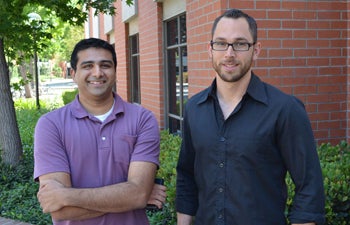Adding Up to a Robust CAREER
Aravind Asok and Aaron Lauda, both assistant professors of mathematics at USC Dornsife, have been selected to receive National Science Foundation CAREER awards.
The Faculty Early Career Development (CAREER) Program is a foundation-wide activity that offers the National Science Foundation’s most prestigious awards in support of junior faculty who exemplify the role of teacher-scholars through outstanding research, excellent education and the integration of education and research.
Lauda’s award is based upon his proposal, titled “Interactions between knot homology and representation theory.”
“My research aims to uncover a hidden layer in mathematical structures, revealing a richer and more robust theory capable of describing more complex phenomenon,” he said. “Such extensions of mathematical structures become vital as the frontiers of theoretical physics push the boundaries of our understanding towards a quantum theory of gravity.
“It is a fundamental principle in physics that the science we observe should be independent of the way we describe it.”
This principle is mathematically described using the notion of symmetry and occupies the branch of mathematics known as representation theory. In physical situations where quantum mechanical effects become important, the most natural symmetries are often described in terms of algebraic objects called quantum groups.
Lauda’s research demonstrates that quantum groups are mere shadows of a richer and more robust theory of “categorified quantum groups.”
“The resulting objects are quite sophisticated,” Lauda said. “However, much of the complexity associated with these objects is encoded into a convenient diagrammatic calculus that makes computations simple and intuitive.”

Aravind Asok (left) and Aaron Lauda, both assistant professors of mathematics at USC Dornsife, have each been honored with an NSF CAREER Award in recognition of their teaching and research. Photo by Erica Christianson.
Lauda’s CAREER-supported research will investigate applications of categorified quantum groups to theoretical physics, in particular, topological quantum field theories. An important theme in this proposal is the transfer of ideas between physics and pure mathematics, seeking to make advances on both fronts.
Many of the outreach and teaching activities supported by the CAREER award will utilize the diagrammatic nature of categorified quantum groups, Lauda said, providing an opportunity to visually engage students and transfer algebraic ideas into manipulations of these diagrams.
Unlike the inherently one-dimensional equations of basic algebra, Lauda’s research involves inherently two-dimensional objects that can be combined in much more sophisticated ways.
“One of the defining characteristics of my research is the encoding of these sophisticated two-dimensional objects into a diagrammatic calculus where the basic building blocks are diagrams and gluing together diagrams encodes the elementary operations,” he said. “This diagrammatic formulation is often advantageous because it allows complex calculations to be performed by the more intuitive manipulation of diagrams.”
Lauda noted the inherent challenges of trying to balance the competing demands of being an effective and inspiring educator with those of conducting cutting-edge research.
“Receiving a fellowship from the Alfred P. Sloan Foundation recognizing my research contributions was a great honor,” he said. “However, I am especially honored to receive the NSF CAREER award as it is one of the few awards that recognizes simultaneous achievement in both teaching and research.”
Asok’s award is based upon his proposal, titled “Vector bundles, rational points and homotopy theory.”

Aaron Lauda’s CAREER-supported research will investigate applications of categorified quantum groups to theoretical physics, in particular, topological quantum field theories. His equations are shown. Photo courtesy of Aaron Lauda.
One of the most basic questions in mathematics, going back to Diophantus, the Alexandrian Greek mathematician known as the “father of algebra,” is: given a system of polynomial equations with whole number coefficients when can one guarantee existence of a whole number solution?
“Associated with such a system of polynomial equations is a geometric object — think of the graph of the equation — called an algebraic variety,” Asok said. “A basic idea of my research is to tie the ‘structure’ of this geometric object to the solubility problem mentioned above and other similar questions.”
Asok’s CAREER award will fund research aimed at better understanding the relationship between solubility of systems of equations and homotopy invariants, which are extremely difficult to compute.
“One learns in algebra how to solve a system of two linear equations in two unknowns. What happens if one considers larger systems of linear equations and allows the coefficients of the equations to vary? If the coefficients are constrained — say they satisfy a system of polynomial equations — the homotopy invariants considered above again control solubility.”
Asok said he was honored to have had his research recognized by the NSF and was also particularly excited about the funding the CAREER award provides for outreach activities, including training. Asok plans to use that component of his award to organize a small workshop for graduate students each summer for the next four years
“The kinds of techniques I’ve been using in my research are very new, and while there are some written sources from which students can learn, there are still many things one can only learn by conversing with experts. These small workshops are meant to bridge this gap by putting interested students in direct contact with experts.”
Asok will also use his CAREER award to provide funding for a joint project with the artist Lun-Yi Tsai, a painter and sculptor who trained as a mathematician and whose work explores interconnections between the apparently divergent disciplines of art and mathematics.
“Many people think of mathematics as synonymous with numbers, but for those of us interested in geometry and topology, visual representations are used everywhere,” Asok said. “Tsai is a visual artist, trained as a mathematician, and he conceived the idea of having public discussions between artists and mathematicians around themes of mutual interest. We hope that these discussions can demystify some aspects of what mathematicians do on a daily basis.”